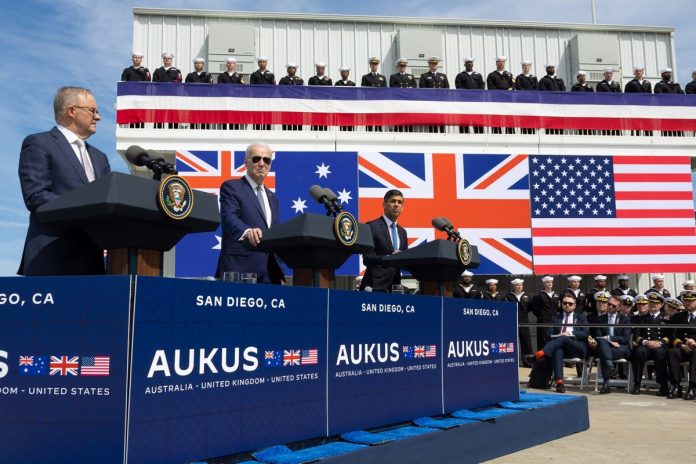
By Nishank Motwani*
AUKUS is one of the most ambitious allied defence undertakings in decades. But for all the high-end platforms and advanced capabilities it promises, a fundamental question remains underexplored: what, exactly, is AUKUS seeking to deter? From The Strategist. The Australian Strategic Policy Institute.
The behaviour set that we want to deter is not self-evident. AUKUS has often been described as a way to ‘complicate Beijing’s decision-making calculus’ and ensure that President Xi Jinping wakes up every morning and says, ‘not today.’ Australia’s 2024 National Defence Strategy (NDS) establishes a strategy of denial as the cornerstone of defence planning, but this broad ambition lacks the precision needed to guide investment, prioritise technologies and convey clear thresholds of unacceptable behaviour to adversaries. If we are serious about generating credible deterrent effects, we must first clarify which behaviours we want to stop.
This is where definition of a behaviour set becomes critical. AUKUS partners must decide which specific behaviours they want to deter—whether they’re cyberattacks on critical infrastructure, attempts to blockade Taiwan, deployment of maritime militias in disputed waters or transfer of sensitive military technology to proxy actors. This clarity is not only foundational to aligning threat perceptions and deterrence priorities among the three nations; it is essential to guide the development of capabilities under AUKUS Pillar One (nuclear submarines) and, more urgently, under Pillar Two (other technologies).
This is not an argument against the enterprise; it is an argument for sharpening its purpose.
When AUKUS was announced in 2021, public attention fixated on Australia’s future fleet of conventionally armed, nuclear-powered submarines. That debate, often reduced to cost comparisons with diesel-electric submarines, missed the broader strategic purpose. Nuclear attack submarines provide greater range, stealth, speed and endurance, allowing them to operate far from Australia’s shores and to remain undetected in contested environments. They are instruments of deterrence that complicate an adversary’s risk calculus.
But the deterrent value of AUKUS does not reside solely in the eventual arrival of nuclear submarines. AUKUS generates deterrent effects along the way. Forward rotational deployment of US and British nuclear-powered submarines to Western Australia increases allied presence in the Indo-Pacific, strengthens joint operations and disperses assets in ways that make them harder to track and target. These actions signal resolve and contribute to deterrence immediately.
AUKUS is also laying the groundwork for fundamental realignment of the partners’ defence industrial bases. Reforms are being implemented to remove barriers to innovation, streamline information-sharing, and create the conditions for joint research, development and production. These efforts are about creating an enabling environment where advanced capabilities can be fielded quickly and used to impose costs on potential aggressors.
This enabling environment is particularly relevant to Pillar Two of AUKUS, which encompasses advanced military technologies, including quantum systems, AI, autonomous vehicles, cyber tools, hypersonics and electronic warfare. These technologies offer asymmetric advantages and can be deployed rapidly. But their effectiveness as tools of deterrence depends on one thing: knowing what behaviours they are meant to deter.
The central risk is that without a clearly defined deterrence objective, Pillar Two efforts could become diffuse, driven more by what is technologically feasible than by what is strategically necessary. Technological capability alone is not enough. It must be linked to purpose. Strategic clarity will help identify demand signals, focus innovation and guide experimentation—because deterrence is about sending signals, and ambiguity works only if adversaries have something clear to fear miscalculating against.
AUKUS was never meant to be business as usual. It is intended to be a blueprint for allied defence industrial cooperation. For this to succeed, the private sector must be brought in as a full partner. That requires clarity from government, including on what specific adversary behaviours the partnership is trying to deter. Industry needs to know where it should focus resources.
At its core, AUKUS is about delivering strategic effects. It seeks to align political, bureaucratic, economic, technological and military ecosystems across three nations to respond to a shared systemic pacing threat posed by China. But delivering effects requires more than intent. It demands cohesion. It requires a shared understanding of how individual investments and actions combine to influence adversary decision-making.
AUKUS has rightly been framed as a long-term bet on peace through strength. But strength without strategic focus risks becoming blunt. And in a world where rivals are moving fast and shaping the strategic environment, AUKUS must do the same—with purpose, focus, and a firm grasp of what exactly it is trying to stop.



AUKUS simply won’t happen those in the know know this too.